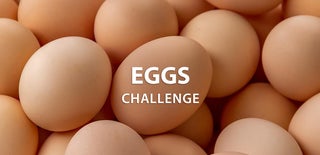Introduction: Laser-engraved Eggs
Laser engravers are fun and creative devices, but perhaps few know that they can be used to engrave the shells of eggs. The egg is an interesting canvas. It has limitations but still provides many possibilities.
Supplies
Tools
Laser engraver
Optional: electric drill with 1/8" bit
Materials
Eggs
Step 1: Select Eggs
Brown eggs are only brown on the surface, as the dark pigment is laid down on top of a white shell late in the process of the eggs passing through the chicken's oviducts. Hence, when engraved, the brown surface is burned off and the design is rendered in white. Fortunately, I have a flock of 35 chickens of various breeds that provide me with a diversity of egg colors. Marans lay very dark eggs, which are a good choice here as they provide the greatest contrast. Lighter colored eggs can be engraved, but the result is less pleasing. Examine the photos above to see some experiments with shell color.
Step 2: Create Text and Graphics
You can print almost anything on an egg, even if you don't have a roller attachment for your laser engraver. Perhaps the most epic thing you can do with this instructable is to surprise a child with an Easter egg that has their name on it. Or you can get creative and put funny sayings on eggs for parties and pranks. Use interesting but readable fonts. You can download free clip art from the internet that will engrave very well. Choose simple patterns without too much detail. Remember, your canvas is small. Example: search "clipart chicken black and white." A am going to assume that you know how to operate your laser engraver and the software that drives it. I use an Atomstack A5 engraver with LaserGRBL software.
Step 3: Engrave Text
Without a roller, the easiest way to engrave text is longitudinally, that is, along the length of the egg. Thirty mm of length was about right for my eggs. Set up your text as separate files one or two lines at a time, then rotate the egg as needed. Use small weights if necessary to hold the egg in place and perhaps some spacers to prop up the pointy end. Center the egg under the laser and check the perimeter of the engraving using the Frame command. Egg shell is so easily engraved that even though the surface is not in a plane, the parts that are out of focus will still engrave well.
Engraver variables: I used minimum power, 5%. I vectorized all graphics and text, used horizontal fill at 1 line/mm. You don't need a lot of power. You don't want to cook the eggs! Engraving will produce the smell of burning hair because of the protein in the shell. I usually use raw eggs, but it will work on hard-boiled eggs or hollow (blown) eggs. With these variables, and the small sizes involved, 25-30 mm, each engraving requires only about a minute. See the video for an example.
Pro tip: engrave all of the text on the sides of all eggs at the same time. If you use eggs of about the same size, you won't need to change the focal distance on the engraver. When you are done with that, you can move on to engraving things on the ends, which will require a change in focal length.
Step 4: Engrave Graphics
The blunt end of the egg, containing the air cell, provides a good site for a small graphic of about 25 mm. A more-or-less circular graphic works well. A bean bag can be used to hold up the egg, but it will stand up by itself if you use a honeycomb-type base under your engraver. You can, of course, combine text and graphics for one superbly engraved egg, as done with a few here. Practice as much as you like--you can always eat the mistakes!
Step 5: The Instructable Within an Instructable: How to Blow Eggs
If you want your engraved eggs to last, you might wish to empty them of contents via the traditional blowing technique. In summary, you make a hole in each end of the egg, put your lips over one hole and blow the raw egg out the other. You have to blow pretty hard. It's easier to blow out the raw egg if you break the egg membrane, though the contents may begin to leak out before you're quite ready. I find that using an electric drill at high speed works well for making the hole. If you use a low speed, the egg shell may break. See photos for details.

Participated in the
Eggs Challenge













